Oil and Gas Well Drilling and Servicing eTool
Oil and Gas Well Drilling and Servicing » Plugging and Abandoning Oil and Gas Wells
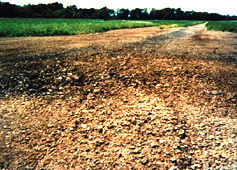
(Source: OSHA)
An oil or gas well is plugged and abandoned when it reaches the end of its useful life or becomes a dry hole. These operations include activities and tasks that present hazards to workers. The following sections discuss some of the hazards that could most likely be encountered during well plug and abandon operations and present possible solutions to these hazards.
Plug and abandon operations include:
- Preparing the well site for abandonment activities. Precautions are taken to ensure the well is safe to work around. The site is assessed to ensure safe access and egress, soil condition and stability, contour of terrain, presence of plants and/or animals, potentially hazardous atmospheres near the well, traffic and movement, equipment staging and other hazards at the site.
- Removing and salvaging available well bore casing, tubulars, and other equipment. Tubulars are removed through the process of freepoint/backoff, stretching, or by simply cutting off the tubulars at a predetermined depth using chemical cutting, explosives, hydraulic cutting, or pulling methods.
- Removing stuck tubulars above the cut using fishing tools. Tubulars below the cut are left in the wellbore.
- After removal of free tubulars, removing stuck tubulars above the cut using fishing tools. Tubulars below the cut are left in the wellbore.
- Placing cement plugs in the borehole and testing to prevent migration of fluids between different formations. Plugging is subject to federal and state regulations. Regulations may vary from state to state.
- Cutting upper casing below grade and capping the well before the surface is reclaimed to match the surrounding environment. Reclaiming activities are subject to federal and state environmental regulations. Regulations may vary from state to state.
Hazards may be related to the following:
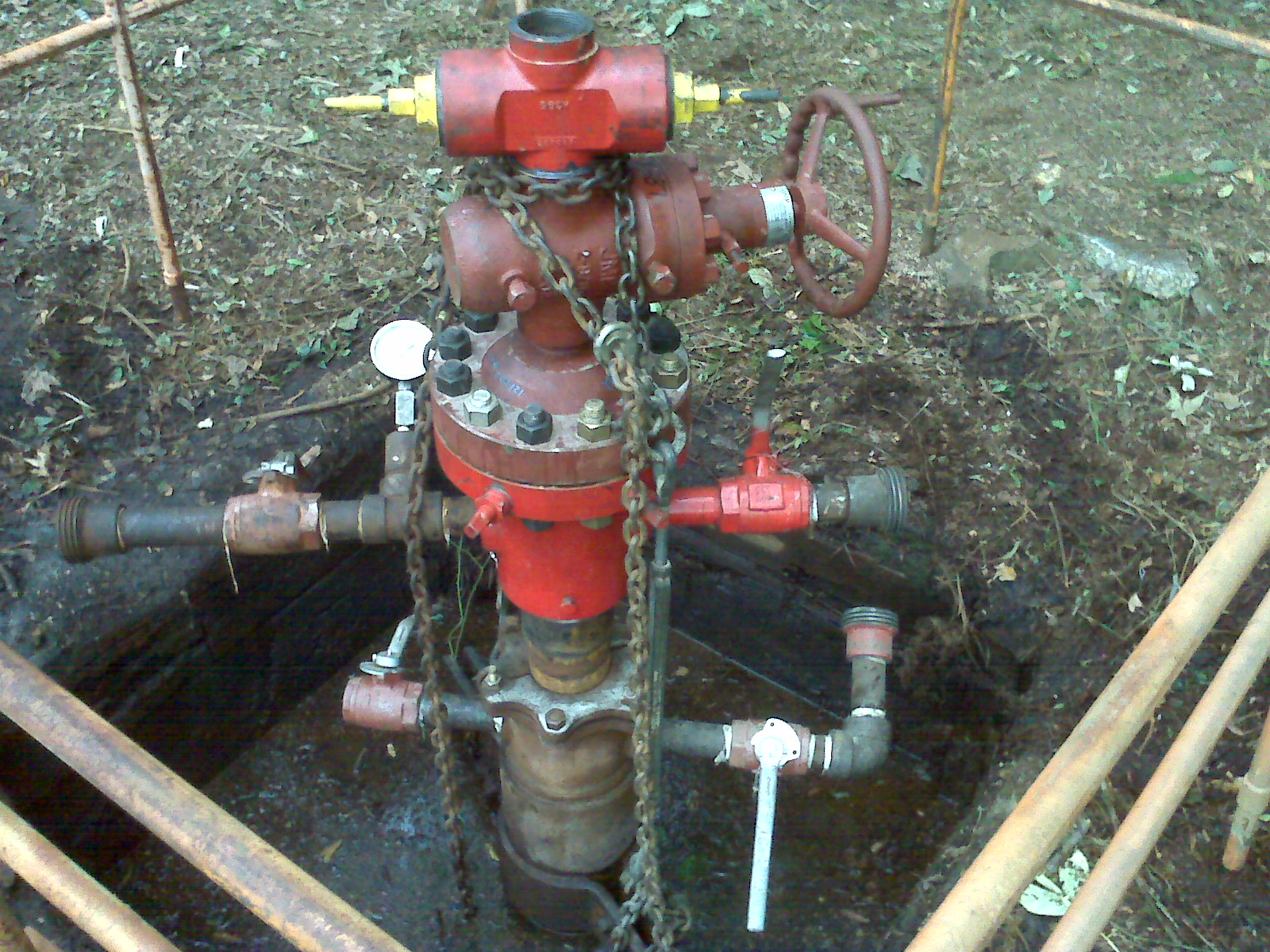
Preparing a wellsite for abandonment includes removal and salvaging of a variety of equipment. Equipment staging, movement, and demolition can lead to struck-by/caught-in hazards as well as ergonomic hazards. Escaping well liquids, gases or vapors can lead to fire and explosion hazards.
Potential Hazard
- Exposure to other hazards similar to those encountered during regular drilling or workover operations (such as vehicle hazards, struck by/caught in hazards, slip, trip and fall hazards, fire, and explosion hazards, etc.).
Possible Solutions
- Conduct a Job Hazard Analysis (JHA) for struck-by/caught-in hazards and ergonomic hazards.
- Conduct a fire risk assessment relating to fire and explosion hazards. See the following hazard alerts developed through OSHA’s Alliance with the National STEPS Network and NIOSH:
- Other solutions are similar to those found in Tripping Out/In and Casing Operations.
Incident Examples:
When reviewing these incidents consider which of the Possible Solutions listed above could have prevented the incident.
- A work crew involved in a plug and abandon operation at an oil well-site used propane weed burners to thaw frozen valves on the wellhead. Gas was released from the wellhead and was ignited, setting fire to the wellhead equipment and the surrounding area. Three employees were hospitalized with burns to their bodies.
- Four workers from a well servicing company were at an oil well site which was scheduled for temporary abandonment. Prior to decommissioning the well, paraffin needed to be removed from the well to run a mechanical integrity test to check for leaks in the well casing. A hot oil truck arrived on site to pump hot water down the well to melt the paraffin. Before pumping the water down the well, the blowout preventer (BOP) was opened. When the BOP was opened, oil and gas began to blow out. The well servicing workers came to assist in closing the BOP, but the extension arm to the BOP fell off. As the crew tried to reattach the extension arm, the oil and gas ignited. All five of the workers involved in the event sustained multiple burns. Four of the five workers were flown to the local burn center.
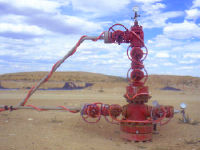
A rig is typically used to remove tubulars and to plug the well.
Once safe to do so (i.e., that there is no residual pressure and no hazardous materials will discharge when the wellbore is accessed), the wellhead is removed and a determination is made as to what depth the tubulars will be salvaged (maximum depth for optimal recovery). This determination can be made by the use of electric wireline services called freepoints/backoffs, or by calculating the stretch of the tubulars when force is applied, or by simply cutting the tubulars at a depth determined by the company.
Freepoint is a wireline method by which the location of "free pipe" is determined so that the appropriate backoff and cut can be made above the point where the tubulars are stuck or cannot be removed due to downhole conditions. A freepoint tool is lowered into the wellbore and secured to the tubulars at varying depths. Tools use either pipe torque or stretch to determine the freepoint. The string is pulled, or pulled and twisted with the tool in position. A meter at the surface is read which indicates where the pipe is stuck and where it is free.
The stretch method uses a measuring device to measure the length of stretch on the string when the rig is pulling on the tubulars. The measured stretch length is used to calculate the approximate depth at which the tubulars can be removed based on the known rated design stretch of the tubulars.
A company may also decide to cut the string at a predetermined depth without using the freepoint or stretch methods based on their knowledge of the well.
Once the depth determination is made, there are several methods to shear the pipe. This can include the use of chemical cutter, explosives, hydraulic cutters, radial cutting torches, or simply pulling until the tubulars separate. After the tubulars are cut or separated they are removed from the wellbore.
Potential Hazards
- Struck by rig equipment (such as casing jacks, power tongs, and casing elevators).
- Exposure to other hazards similar to those encountered during regular drilling or workover operations (such as vehicle hazards, struck by/caught in hazards, slip, trip and fall hazards, fire and explosion hazards, etc.).
- Exposure to chemical cutter (i.e., bromine trifluoride).
- Exposure to explosives used for severing the tubulars.
Possible Solutions
- Conduct a Job Hazard Analysis (JHA) for struck-by/caught-in hazards and ergonomic hazards.
- Follow American Petroleum Institute (API) Recommended Practice (RP) 67, Recommended Practice for Oilfield Explosive Safety, when using explosives.
- Comply with all Safety Data Sheet (SDS) requirements for bromine trifluoride when chemical cutting is performed.
- Conduct a fire risk assessment relating to fire and explosion hazards. See the following hazard alerts developed through OSHA’s Alliance with the National STEPS Network and NIOSH:
- Other solutions are similar to those found in Tripping Out/In and Casing Operations.
Incident Example:
When reviewing this incident consider which of the Possible Solutions listed above could have prevented the incident.
- Three workers went to a well that was to be abandoned. The well had a history of high-pressure natural gas and had produced natural gas for many years. The casing pullers released the pressure from the well. On the day of the incident, the work-over rig stretched the casing to determine its free-point, which was determined to be about 2,200 ft. The casing was shot at 2,122 ft and 20 joints of casing were pulled from the well. The casing pullers were circulating mud in preparation for cementing the well when a pocket of hydrocarbons blew out of the well. The gaseous and liquid hydrocarbons were apparently ignited by the pump engine on the rear of the pump trailer. The three workers sustained burns, for which they were hospitalized.
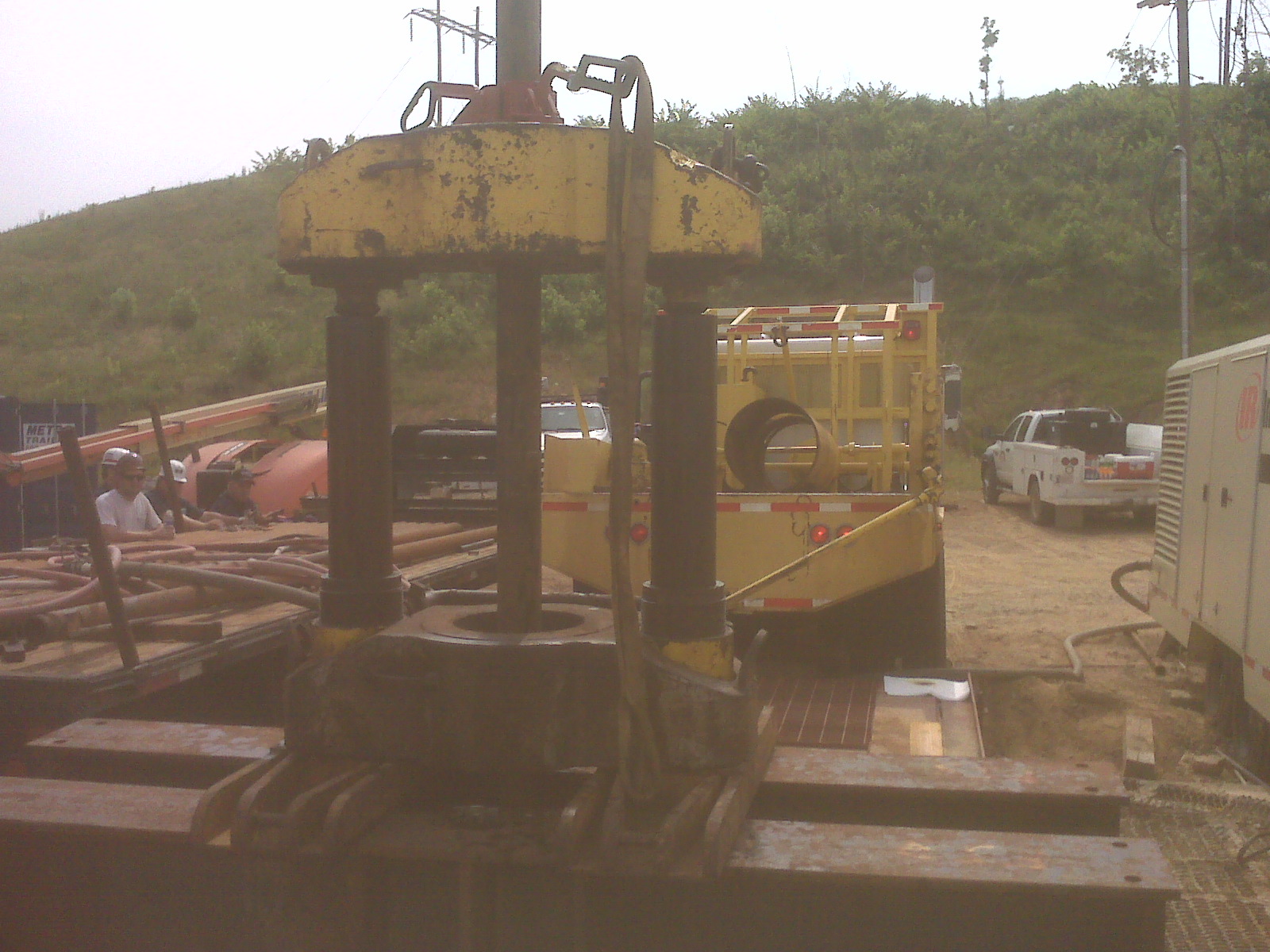
After tubulars are freed downhole, they are ready to be removed from the wellbore. This is usually accomplished with a rig assist or with casing jacks. A proper Job Hazard Analysis (JHA) or Job Safety Analysis (JSA) should be prepared before operations begin and used throughout the operation. Casing jacks are mainly used to pull casing when it is unsafe to use a rig to do so, either because the string weight is beyond the safe operating limits of the rig, or because the casing is not structurally stable and parting is possible.
Potential Hazards
- Struck by rig equipment.
- Exposure to other hazards similar to those encountered during regular drilling or workover operations (such as vehicle hazards, struck by/caught in hazards, slip, trip and fall hazards, fire and explosion hazards, etc.).
- Exposure to tubulars containing Naturally Occurring Radioactive Material (NORM), especially when the well has been in production for a longer period of time. Properly monitor the tubulars for NORM and take necessary precautions as outlined in OSHA Publications (see references section).
Possible Solutions
- Conduct a Job Hazard Analysis (JHA) for struck-by/caught-in hazards and ergonomic hazards.
- Conduct a fire risk assessment relating to fire and explosion hazards. See the following hazard alerts developed through OSHA’s Alliance with the National STEPS Network and NIOSH:
- Other solutions are similar to those found in Tripping Out/In and Casing Operations.
Incident Examples:
When reviewing these incidents consider which of the Possible Solutions listed above could have prevented the incident.
- Four workers were attempting to service an oil and gas well in order to abandon it. In an attempt to release existing pressure against the packer, the crew unscrewed the production tubing from the packer. As a result, uncontrolled oil and natural gas were released from the well to the atmosphere and was followed by an explosion. Three workers suffered multiple burns and one worker died as a result of the explosion.
- Three workers were preparing a wellhead and dual assembly (Christmas tree) for plugging and abandonment. A wireline worker was struck by a 2,000 pound lubricator. As one of the workers slowly opened the Christmas tree's master valve to equalize the pressure from the well to a wireline lubricator, the 2,000 pound lubricator blew off the tree, striking one of the wireline workers in the back resulting in his death.
In some instances, after the tubulars have been cut, they cannot be removed by simply using the rig. Often as the tubulars are being pulled from the wellbore, the tubulars stick at bends or obstacles along the wellbore. When this occurs, fishing tools are used for removal. There are many types of fishing tools used (e.g., hydraulic jars, spears, and overshots) that are inserted into the wellbore via a drill string or wireline. These methods provide the operator additional pull or torque to assist with the removal of the tubulars.
When operations do not require a derrickman present in the rod or tubing board above the operation, or floor hands present in the immediate vicinity of the operation at the wellhead or on the floor, they should be removed or isolated from the hazard area.
The types of operations requiring a derrickman or floor hands vary from job to job and should be evaluated with the use of a proper JHA or JSA before operations begin. This may include, but not be limited to, fishing operations, wireline operations (especially those involving explosives like pipe cutting), jarring, hoisting, spudding, loosening, setting, rotating, or any other operations as identified by the JHA/JSA.
Potential Hazards
- Struck by fishing tools or rig equipment.
- Exposure to other hazards similar to those encountered during regular drilling or workover operations (such as vehicle hazards, struck by/caught in hazards, slip, trip and fall hazards, fire and explosion hazards, etc.).
Possible Solutions
- Conduct a Job Hazard Analysis (JHA) for struck-by/caught-in hazards and ergonomic hazards.
- Other solutions are similar to those found in Tripping Out/In and Casing Operations.
Incident Example:
When reviewing this incident consider which of the Possible Solutions listed above could have prevented the incident.
- A crew was contracted to remove stuck tubulars from a wellbore. With the fishing tool attached the crew measured the force required to break the string free. The force was close to the rated capacity of the rig. After pulling and removing over 20 joints in the string, the string got stuck again. The force on the rig was pulled to the same as initially applied but without consideration of the additional load on the rig being applied from the pulled joints mounted on the rig. The rig became unstable and toppled over. A derrickman on the tubing board was crushed by the mast when it fell and two floor hands were seriously injured from jumping off the operating deck.
Cement plugs are placed in the borehole to prevent migration of fluids between the different formations. This also prevents the migration of gas or fluids to the surface. After placement, pressure testing is performed to ensure that the plugs are tight. Tests may also include air monitoring above the plug for hydrocarbon gas and/or vapor emissions, and if liquid releases occur, they will be seen around the plug. State and federal regulations should be consulted and followed when performing plugging operations that are associated with well abandonment.
Potential Hazards
- Struck by pressured lines when pumping cement.
- Exposure to silica, or toxic liquids, vapors, or gases.
- Exposure to other hazards are similar to those encountered during regular drilling or workover operations (such as vehicle hazards, struck by/caught in hazards, slip, trip and fall hazards, fire and explosion hazards, etc.).
Possible Solutions
- Conduct a Job Hazard Analysis (JHA) for struck-by/caught-in hazards and ergonomic hazards.
- Inspect cementing equipment and pressurized lines prior to use.
- Restrain lines and instruct personnel to stand clear of pressurized lines.
- Conduct a fire risk assessment relating to fire and explosion hazards. See the following hazard alerts developed through OSHA’s Alliance with the National STEPS Network and NIOSH:
- Other solutions are similar to those found in Tripping Out/In and Casing Operations.
Incident Examples:
When reviewing these incidents consider which of the Possible Solutions listed above could have prevented the incident.
- A well casing pulling and plugging company was contracted by a production company to plug a well to be abandoned. The crew had set the bottom plug and had pulled approximately two joints of tubing out of the well when the well experienced a kick . The crew was working with an open hole; no well control device was being used. The well rapidly started to increase pressure with oil spraying as high as 60 feet. The hydrocarbon mist was blowing over the cement pumping equipment, which was operating within 20 feet of the well when the hydrocarbon mist ignited. According to witnesses, the ignition started at the trucks pumping the concrete and water. One witness observed the flame travel from the trucks into the well. An employee was on the tubing board with no emergency means of escape. The employee jumped from the tubing board approximately 45 feet to the ground. As a result, the worker died from his injuries.
- During a plug and abandon operation at an oil/gas well, a kick or blowout occurred while a service company was pumping a cement plug into the hole. No blowout prevention devices were used, which allowed flammable concentrations of gas to accumulate around the well. A diesel pickup truck that was left running 40 feet away from the well began to overspeed (i.e., a runaway diesel engine), as a result of the natural gas entering the air intake. The truck did not have a kill switch or a heat and spark arresting exhaust system, and it subsequently ignited the surrounding vapors, causing an explosion. Five workers sustained burn injuries, three of those were hospitalized.
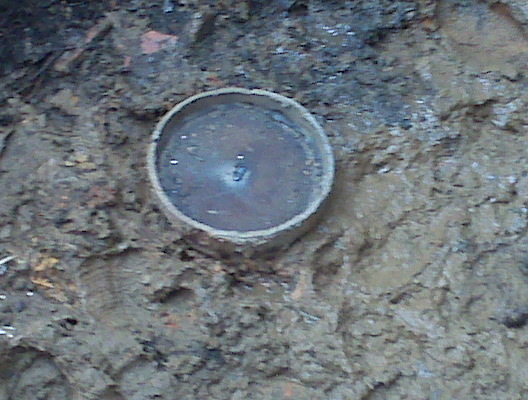
After all tubulars are removed and cement plugs set and tested, the wellhead is excavated around the surface casing and the casing cut off below ground level. A cap is added and the well is covered to prevent future surface exposure of the well. The area is then restored to its natural condition. Requirements for abandonment may differ from state to state. Consult your state and local requirements for specific abandonment procedures.
Potential Hazards
- Exposure to confined spaces or excavation/trenching work around the wellbore.
- Fire or explosion from ignition sources when cutting or welding on tubulars.
Potential Solutions
- Conduct a fire risk assessment relating to fire and explosion hazards. See the following hazard alerts developed through OSHA's Alliance with the National STEPS Network and NIOSH:
- Ensure all permits for confined space or excavation/trenching work are properly completed.
- Eliminate hydrocarbons present in the workspace if cutting or welding will be performed.
Incident Example:
When reviewing this incident consider which of the Possible Solutions listed above could have prevented the incident.
- A welder and a helper were capping abandoned oil wells. They found that the well they were to work on had been plugged with cement at some undetermined date and then capped. An 8 foot deep excavation had been dug around the well. The welder entered the pit to cut the pipe 3 feet below ground level. He was unaware that oil had seeped around the plug and into the pipe area where he was going to cut. After the cutting operation started oil sprayed out of the pipe. The cutting torch ignited the spewing oil and also his clothes, which were covered in oil. As a result the welder sustained fatal burns. In this case, the employer had not utilized any of the methods listed in API Bulletin E3, 2.5, Plug Placement Verification, to verify that the plug had been set correctly, nor had it used a vacuum truck to assure that all liquids and gases had been removed before the pipe was cut, capped, and buried. Note: An eight foot deep excavation should also be considered as a confined space and be evaluated as a permitted space in accordance with 29 CFR 1910.146.

Additional Information:
- API Bulletin E3, Environmental Guidance Document: Well Abandonment and Inactive Well Practices for U.S. Exploration and Production Operations (reaffirmed June 2000), addresses the “environmental concerns related to well abandonment and inactive well practices” including “protection of freshwater aquifers from fluid migration, as well as isolation of hydrocarbon production, and water injection intervals.” Additional issues addressed in the document include “protection of surface soils and surface waters, future land use, and permanent documentation of plugged and abandoned (P&A) wellbore locations and conditions.”

